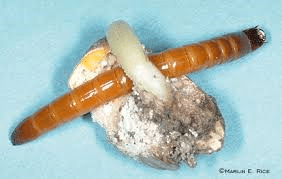There are about 1000 North American species and most larvae in this family are slender, hard-bodied and shiny, which is how they got the name “wireworms”. Many are found in the soil where they feed on newly planted seeds and roots of plants, including some important crops such as corn, cereals, cotton, beans, and potatoes.

Some species may live from 2 to 6 years as larvae in the soil. Insecticide seed treatments such as Poncho or Cruiser typically provide good control of plant-feeding pests on seedling crops that are most susceptible. There were few, if any rescue treatments for wireworm infestations if at-planting insecticides or seed treatments are not used..
The adult form of these insects are commonly known as click beetles and they belong to the insect family Elateridae. Though the larvae may be destructive pests of many of our crops, the adults are not. Click beetles are distinctively shaped, parallel-sided beetles with sharp points at the hind corners of the large, mobile prothorax. It is not uncommon to find a click beetle on a drop cloth in cotton or in a sweep net sample from soybeans. These beetles have a truly astounding ability to jump. If disturbed, click beetles often drop from foliage as a defense mechanism. If a click beetle lands on the ground on its back and cannot right itself, it will flex its thorax (the middle section between the head and abdomen) so that only the head and back touch the ground. When it bends like this, it is actually pushing a peg-like projection from the underside of the thorax against a catch between its middle legs. When that peg slips off the catch, it makes a distinctive clicking sound, hence the name “click” beetle. The front and back parts of the beetle snap up in a jackknife shape and sends the beetle flipping end over end into the air. If the beetle lands on its back again it simply “jumps” again. This jump takes place in a fraction (1/2000) of a second giving the beetle an almost instantaneous takeoff at a speed of about 8 feet per second. The initial acceleration exceeds the “force of gravity” by several hundredfold. This jumping ability makes it difficult for predators to hold on to click beetles, which makes it a very valuable trait. It is especially impressive to think this jumping is done without the use of its legs.

One of the most recognized members of this family are called eyed click beetles, Alaus spp.. This is a large widespread species with huge conspicuous eyespots on top of the prothorax. These are most often found near dead wood where their larvae feed on other insects.
Interestingly, adult members of the species Pyrohorous may be found in the southern states and in the tropics and have three light-producing spots on their adult body. The light is brighter than that emitted by lightning bugs and makes for a striking sight when many of these insects are flying at night.
References:
Marshall, S. A. 2006. Insects: Their Natural History and Diversity. Firefly Books Ltd. Buffalo, NY 14205. Pgs. 270-271.
Triplehorn, C. A. and N. F. Johnson. 2005. Borror and DeLong’s Introduction to the Study of Insects, Seventh Edition. Brooks/Cole, Belmont, CA 94002. Pg. 422.

